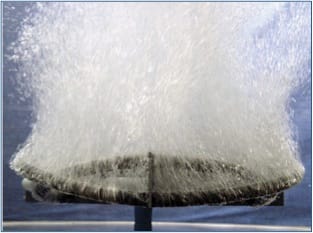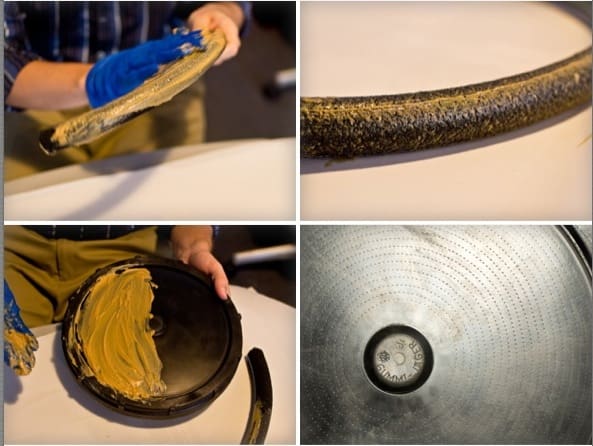Wastewater lagoon fine bubble aeration is a common way that facilities efficiently meet the treatment standards of state environmental regulating bodies. Since aeration typically accounts for at least 50–60% of the energy costs associated with aerated lagoon treatment, selecting the right lagoon fine bubble aeration system is crucial to the efficient operation of a wastewater lagoon facility over the long run. Unfortunately, this is the real world. Wastewater treatment aeration systems cost money and NOT all lagoon fine bubble aeration systems are created equal.
In this short article we will examine the different lagoon fine bubble diffuser technologies on the market today. By evaluating them in terms of aeration efficiency, maintenance, and mixing capability, we hope you will better understand the differences between them. The truth is that a system that appears to have high oxygen transfer efficiency in a lab may not achieve the same performance when installed in an actual wastewater lagoon. The least expensive fine bubble aerator may cost less upfront but cost more in the long run in energy and maintenance. And, as with any partial mix aerated lagoon system, without taking mixing into account, you are liable to see some sludge accumulation in your lagoon over time that will likely cost you hundreds of thousands of dollars to remedy.
Learn more about fine bubble aeration systems by reading our previous article: Fine Bubble Aeration in Wastewater Lagoons: Pros and Cons.
There are two broad categories of fine bubble aerators for lagoons: those with “static orifices” and those with “dynamic orifices”—we will consider both types below.
Static Orifices in Fine Bubble Aeration Systems

Static orifices are rigid holes that air leaks out of under water. Because the orifices are rigid, they are less flexible, susceptible to clogging and not able to accept more air than they were designed for.
Examples of these types of diffusers are:
- Perforated LDPE (Low Density Polyethylene)—this is LDPE pipe with holes punched into it.
- Bubble Tubing—This is often recycled car tires extruded into a tube, similar to the subsurface irrigation tubing found at hardware stores.
Pros of Static Orifices
These static orifice systems are generally cheap when it comes to capital costs. Furthermore, they are very efficient in clean water lab testing, since there are no items in the water to clog the orifices.
Cons of Static Orifices
Due to the fact that the orifices are static, they cannot seal if the air supply is turned off. This can lead to water backflowing into the piping and the potential for solids to clog the orifices. Clogged orifices will lower overall oxygen transfer and increase power consumption due to increase in backpressure at the blower. As a result, the clean water aeration efficiency that promised low energy consumption quickly becomes irrelevant as the blowers have to consume more energy to push air through fewer orifices.

Static orifice diffusers tend to be more maintenance intensive overall. This is primarily due to fact that once bacteria begin to foul the diffuser, as is the case with any fine bubble diffuser, the only options an operator has are to either clean or replace the diffuser. Cleaning can involve either physically pulling up the unit and scrubbing it or pumping toxic chemicals into the air lines to kill the bacteria. Either approach is undesirable and becomes expensive over time. It is for this very reason that the vast majority of larger activated sludge plants do not utilize static orifice fine bubble diffusers.
Lastly, this type of lagoon fine bubble aeration is unable to generate much mixing in the water column. Without any turbulence in the water, sludge tends to build up at the bottom of the lagoon. This only exacerbates the clogging problem of the orifices, as more sludge means that there is more substance that could find its way into the pores of the diffusers. Moreover, excessive accumulation of sludge will lead to the expense of needing to dredge your lagoon. For more information see our blog on the Causes and Effects of Wastewater Lagoon Sludge.
Dynamic Orifices in Fine Bubble Aeration Systems

For municipal lagoon wastewater treatment, the typical dynamic orifice aeration diffusers used are composed of a perforated EPDM (Ethylene Propylene Diene Monomer) rubber material (a.k.a. diffuser membrane). As air is pumped through the membrane material the orifices open up as a result of the air pressure and release bubbles.
Pros of Dynamic Orifices
Dynamic orifices are more robust than static orifices and do not clog as easily because of their ability to expand and contract. Secondly, since this material is malleable, it is equipped with a “self-cleaning capability.” By bumping the airflow up a notch, the orifices will expand and expel any surfactants that have begun to build up or clog them. Due to these features and a much lower risk of clogging, dynamic orifices tend to have a much more efficient long term field transfer efficiency than static orifices.
Cons of Static Orifices
Similar to static orifices, dynamic orifices are unable to generate a level of mixing that will prevent sludge buildup. This means that treatment overall may suffer, and—despite the “self-cleaning” feature—may result in more regular maintenance to the diffusers due to sludge buildup.
Furthermore, the airflow per unit is going to be pretty similar to that of static orifices. This means that the number of units necessary to treat an entire wastewater lagoon will sizable.
Ares Aeration®
Triplepoint’s Ares Wastewater Lagoon Aeration harnesses the pros of the dynamic orifice fine bubble diffusers while eliminating the cons. Ares utilizes patented Double Bubble™ technology, which combines two components integral to proper wastewater treatment. The first component is a dynamic orifice fine bubble membrane, which harnesses the benefits of efficient oxygenation. This feature utilizes the EPDM material mentioned above in the Dynamic Orifices section. Therefore, the efficient field transfer efficiency and self-cleaning benefits are maintained.
The second component works in collaboration with the fine bubble membrane; the coarse bubble static tube aerator. This provides substantial turbulence and mixing to the lagoon, which help Ares treat the entire water column. As a result, sludge buildup is decreased, and risk of maintenance to the units, or backpressure from clogging, is decreased substantially. Together, these components allow Ares to oxygenate and treat water effectively while still using energy efficiently.

